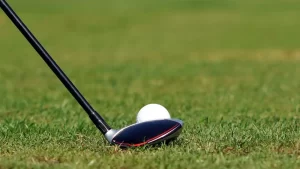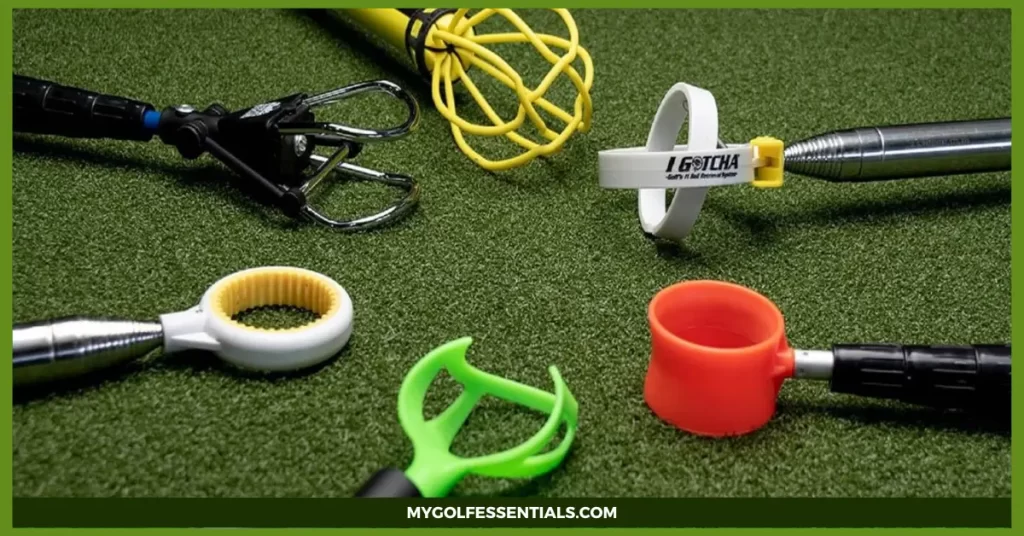
Golfers of all skill levels welcome the ultimate guide to choosing the best golf club distance for your game! Many amateur golfers don’t realize how much a slight change in their club selection can affect their performance on the green. If you want to improve your accuracy and maximize your shot distances, this article will provide essential information regarding the relationship between different clubs and distances.
We’ll cover everything from wedge selection to drivers and discuss factors contributing to successful distance control with each club. Let’s jump right into it and get closer to shooting par scores!
Introducing the Golf Club Distance Chart
The golf club distance chart is an invaluable tool to help you make the most of your game. By understanding how far certain clubs travel, you can adjust your shot selection and get closer to the pin more often than not.
Let’s take a look at the different clubs and their distances:
• Wedge:
The wedge is the most versatile club in your bag and can travel short to long distances depending on how you apply the loft. In general, pitching wedges (PW) usually fly between 75-90 yards for men and 60-80 yards for women.
• Irons:
The 5 iron through 9 iron are designed for shots ranging from 120-180 yards for men and 80-150 yards for women.
• Woods:
The 3-wood and 5-wood are best used for long shots around 200-240 yards for men and 140-170 yards for women.
• Drivers:
The driver is the longest club in your bag and can fly up to approximately 300 yards for men and 230 yards for women.
Now that you know the basic distances associated with each club, let’s delve deeper into the factors influencing how far a golf course will fly.
Different Types of Clubs
Before diving into the golf club distance chart, it’s important to understand the different types of clubs typically used in a round of golf.
There are four main categories: woods, irons, wedges, and putters. Woods are usually the longest clubs and are designed for maximum distance. Irons offer less power but more control than woods; they are used to hit shots accurately from longer distances.
Wedges blend distance and control and can be used for more delicate shots, such as pitching or chipping onto the green. Putters are designed for close-range precision and getting the ball into the hole.
Average Golf Club Distance
The average golf club distance chart is an incredibly useful tool for gauging the performance of your clubs. Knowing how far each club in your bag will fly can help you decide which one to use on a given hole. It’s also important to consider that different golfers have different swing speeds and body types, so what works best for another person may not be the best choice for you.
A few factors come into play when it comes to golf club distance. The first is your swing speed, which determines how much power and energy will be transferred to the ball upon impact. If you’re swinging too quickly or slowly, your club won’t reach its full potential. The type of club used will also impact how far it flies. Different clubs have different heads and shafts that determine their performance.
Using a launch monitor, use a golf club distance chart or take practice swings with each club to get an idea of your average golf club distance. Identifying your average distances for each club will make choosing the right club for each shot much easier.
Average Male Club Distances
When selecting the right golf club distance for your game, understanding average male golfers club distances is a great place to start. To begin, let’s look at some typical distances you can expect from common clubs.
Generally speaking, drivers are used for long-distance shots and typically have the longest loft of any other club type. An average man with a driver can expect to hit a ball between 220 and 260 yards. Moving on to fairway woods, these are designed for medium-distance shots that require more accuracy than a driver.
Fairway metals range in the loft from 13 to 18 degrees; an average man can normally hit them between 190 and 230 yards. Moving onto hybrids now, much like fairway woods, hybrids are also designed for medium-distance shots but typically have a higher loft than woods. On average, an average man with a hybrid will hit the ball between 170 and 210 yards.
Next up, we have irons designed to cover almost any distance from short to mid-range. Most golfers carry four iron clubs in their bag – a four-iron, five-iron, six-iron, and seven-iron – the four-iron being the longest at around 160 yards for an average man. The progressively shorter irons cover golf club distances from 140 to 90 yards.
Average Distance for PGA Tour Players
Before delving into the specifics of choosing the best golf club for your game, let’s look at the average distances professional PGA Tour players hit with each club. This information gives us valuable insight into how far an experienced golfer can expect to hit their shots when using high-quality equipment.
We can then develop our strategy for better golf club distance control using this data. Let’s begin with the driver, as this is the longest-hitting club in a golfer’s bag and the one most likely to have the biggest influence on overall distance.
PGA Tour players average around 300 yards off the tee on par fours and par fives with their driver. The average distance for three kinds of wood is 240 yards, and the average distance for five is 200. Moving on to irons, PGA Tour players hit their 7-iron an average of 150 yards, while their 9-iron has an average distance of 135 yards.
The pitching wedge averages 120 yards, and the sand wedge averages 115 yards. Finally, you can expect your lob wedge to travel about 85 yards.
What Impacts Driving Distance on Golf

When it comes to improving your golf game, one of the most important aspects is driving distance. This refers to the length you can achieve with a single stroke from the tee box. While it’s not the only factor that goes into a successful shot, being able to hit long drives off the tee is an invaluable skill for any golfer.
The distance you can hit your golf ball with a given club is affected by several factors. Your technique plays an important role in the distance you’ll be able to achieve, but more importantly, the type of club and shaft you use significantly impacts your driving distance. Let’s take a look at some of these factors in detail:
Golf Club Distance Chart:
You should first understand that different clubs have different ranges and distances. A 3-wood, for instance, will typically hit the golf ball much further than a 7-iron or a pitching wedge. Look at a golf club distance chart to estimate how far each club can carry your shot. This will give you the average distance for each club, depending on your swing speed, strength, and other factors.
Grip:
A firm grip is essential regarding driving distance. If you don’t have a solid grip, you won’t be able to hit the ball as far as possible. Hold the club firmly and grip it with your index, middle, and ring fingers.
Club Head Speed:
Club head speed differs for each golfer, depending on the individual swing. The faster the club head moves through the air, the more energy can be transferred to the ball, ultimately producing a farther shot. To increase your club head speed, practice with a heavier club and gradually increase its weight.
Shaft Flexibility:
A shaft’s flexibility can also affect your driving distance. The more flexible the shaft is, the faster the club head can move through the air, providing more energy to your shot. Generally speaking, lighter clubs (like woods) tend to have more flexible shafts than heavier clubs, like irons.
Club Angle:
The angle at which you address the ball also impacts your driving distance. It won’t travel as far if you’re not hitting the ball straight and true. Make sure to practice keeping a consistent angle when addressing the ball so that your shots will be more accurate.
If you’re looking to maximize your driving distance, it’s important to understand how the different factors mentioned above can affect it. By using a golf club distance chart and ensuring that your grip, shaft flexibility, and angle are in good shape, you should be able to considerably increase your driving distances.
7 Tips to Increase Driver Distance
The driver is arguably the most important club in your bag, and maximizing its potential can significantly improve your game. Before making any changes to your swing or equipment, it is important to understand some key factors affecting how far you can hit with a driver. To get started on increasing your driver distance, here are seven essential tips that every average golfer should keep in mind:
1: Chart Your Yardages
The first step in improving your game is to take the time to accurately chart your yardages. A golf club distance chart will provide a starting point for adjusting your swing and equipment to maximize driver distance. To get the most out of this process, track different variables such as angle of attack, ball spin rate, carry distance, and even overall distances.
2: Improve Your Swing
Improving your swing is the most effective way to increase your driver’s distance. It takes time and practice, but developing an efficient motion will help you maximize the potential of every shot. First, focus on growing your golf muscles and improving your balance with regular exercises. This will make it easier for you to adjust to any changes in club speed or body position during your swing.
Next, practice the proper technique for driving. The takeaway should be smooth and consistent with a slightly descending angle of attack to help you launch the ball further. During the downswing, shift your weight evenly between your feet while maintaining flexibility in your arms and wrists. This will allow you to generate more power through impact and improve carry distance.
3: Hit the Gym to Increase Driving Distance
The golf swing is incredibly complex, requiring power, flexibility, and strength. To maximize your driver distance, you must ensure your body has the necessary capabilities to generate speed at impact.
One of the best ways to do this is by hitting the gym and doing exercises specifically designed for golf performance. Start with a comprehensive fitness program that incorporates all elements of fitness, like strength training, stability work, and aerobic exercise.
This will help you build a strong foundation for your golf swing. Incorporate exercises that target the muscles used in the golf swing to improve your range of motion and generate more power at impact. Make sure to include core strengthening exercises such as planks and Russian twists, as these will give you better balance and stability during your swing.
Flexibility is key for a successful golf swing, so include exercises that target the muscles used in the golf swing, such as leg lifts, shoulder stretches, back extensions, and chest openers. These will improve your flexibility and help you generate more speed at impact.
4: Get Fitted For The Right Golf Clubs
Getting fitted for the right golf clubs is important to any golfer’s game. The right set of clubs can make all the difference in accuracy and distance, so it pays to take the time to get custom fitted by a professional.
Before getting fitted, you should know what you are looking for in terms of club specifications. Different golfers have different preferences, so knowing what will work best for you is important. Factors such as your swing speed, body type, and height can all play a role in choosing the right clubs.
Once you know what you are looking for, you can begin the fitting process with a professional fitter. The fitter will discuss your preferences and goals before conducting various tests to determine the best clubs for your needs. This may include tracking your shots on a launch monitor, analyzing swing speed, or testing different clubheads and shafts.
5: Speed Up Your Tempo
Golf is a game of precision and timing, so having a steady tempo throughout your swing will help you hit longer more accurate shots. Speed up your golf swing tempo to get the most out of every shot.
Take a few seconds to relax your body before taking the club back. This will help you stay relaxed throughout the entire motion, which is important for accuracy and more distance. Once you feel relaxed, it’s time to gradually speed up your tempo. This will help increase the clubhead speed necessary for driving the ball further down the fairway.
6: Start Speed Training
Speed training is an important part of any golfer’s game. It helps improve your swing speed, power, accuracy, and overall performance. Speed training involves a combination of exercises and drills specifically designed to increase the speed of your golf swing.
The best way to get started with speed training is by understanding the key elements of a powerful golf swing. These elements include body position, weight transfer, club head speed, and swing timing. Mastering these key elements will help you increase your driving power and accuracy.
Once you understand the basics, start incorporating speed training exercises into your regular practice routine. Plyometric exercises such as box jumps, medicine ball throws, and lateral hops are great for improving the power and explosiveness of your swing. Incorporate these exercises into a dynamic warm-up routine to prepare your body for practice or competition.
7: Invest in New Equipment
No matter how much you practice, investing in new equipment can make a huge difference to your golf game. Whether it’s a fresh set of clubs or some of the latest technology, updating your gear can help boost your driver’s distance and accuracy.
The right golf clubs are important for maximizing your driver’s distance and helpful for improving swing accuracy. While there are some great off-the-shelf options, custom fitting for a set of clubs tailored to your swing can make all the difference.
A professional club fitter will analyze several key factors, such as height, body type, and swing speed, to recommend the best clubs for you.
FAQs
How Does The Golf Club Distance Chart Work?
The Golf Club Distance Chart is a helpful tool that shows golfers of all skill levels how far their shots should travel for each club. It combines factors such as the swing speeds, ball type, and club loft to provide distances for various clubs. By understanding these distances, golfers can better plan their shots and select the right club for their desired length.
What Factors Affect The Distance Of My Shots?
Several factors affect the distance a golf ball will travel when hit with a specific club. These include the swing speed, ball type, and club loft. The slower your driver swing speed, the less distance you’ll get with each shot. The type of ball and the club loft will also affect shot distance. Combining these factors, the Golf Club Distance Chart can help golfers select the right club for their desired shot length.
How Can I Maximize My Shot Distances?
You must improve your swing speed and select the right clubs for each shot to maximize your shot distances. Slower swing speeds make it more difficult to hit the ball further, so try warming up and focusing on increasing your speed. Then choose the right golf club for your game based on the Golf Club Distance Chart. This will help you get closer to your desired distance.
How Can I Improve My Accuracy?
Improving your accuracy begins with ball placement. Select a spot on the green that’s easy to hit, and use the right golf club for the shot distance. Also, practice regularly and improve your swing speed to help you consistently hit straighter shots. You can improve your accuracy on the green by combining ball placement with improved average swing speed and accurate club selection.
What Are My Options For Increasing Distance?
To increase your distance, you must improve your swing ball speed. Regular practice and drills can help you gradually increase the speed of your swings. Additionally, lighter golf clubs will enable you to generate more speed with each shot. You can also switch to a higher lofted club, which helps hit the ball further up in the air.
Conclusion
I hope this article has provided enough information to help you decide which golf club distance charts is best for your game. Remember that success in golf relies heavily on accurate shot distances, and choosing the right clubs can go a long way toward helping you achieve optimal performance on the green.
Review our Golf Club Distance Chart when selecting clubs and factors such as trajectory, spin rate, and shaft flex. With the right knowledge and understanding of your clubs’ capabilities, you can use them to their fullest potential and take your game to the next level!



